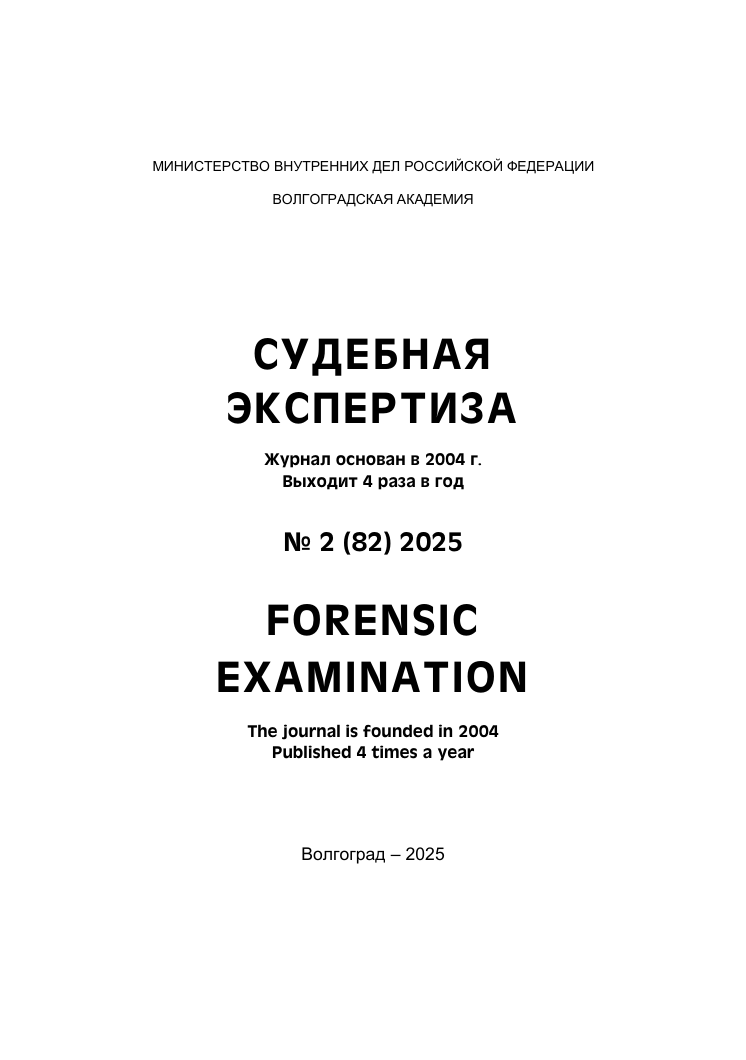employee from 01.01.2019 until now
Moskva, Russian Federation
Russian Federation
The article outlines problematic issues related to the study of animal footprints. It is noted that the correct qualification of a crime is directly dependent on the evidentiary information obtained, including during an inspection of the scene, the effectiveness of which is due, on the one hand, to the professionalism of a forensic specialist, and, on the other hand, to the level of interaction between all participants in the investigative task force. Often, the work of a specialist in examining the scene of an animal attack causes some difficulties, primarily due to the rarity of such crimes, the lack of methodological recommendations for dealing with such crimes, and as a result, the lack of a clear understanding of what kind of investigative information should (possibly) be obtained if it is successfully carried out. For a long time, it was believed that animal footprints at the scene, in particular dogs, could only indicate their presence in the crime scene, the number and direction of movement. At the same time, analyzing the individual standards of dog maintenance and training that currently exist, based on their traces at the scene, one can try to differentiate the attack of stray (stray) dogs from dogs that are kept at home. For example, the dimensional characteristics of the claws displayed in the footprints can be of significant help in narrowing the search range for the dog and its owner. For example, short claws indicate that the dog is regularly and thoroughly cared for, which is extremely unlikely for dogs living on the territory of garage associations, in shelters for homeless animals, as well as on the territory of the house. The article analyzes the possible difficulties that may arise in the process of detecting, detecting, fixing and removing traces at the scene.
inspection of the scene, animal tracks, intent, proof, identification signs, reliability, specialist
1. Belyaev, M. V. Improvement of methods for fixing and removing shoe sole marks found on snow cover / M. V. Belyaev, K. Y. Kotov // Bulletin of Economic Security. – 2022. – No. 5. – pp. 35-41. – DOIhttps://doi.org/10.24412/2414-3995-2022-5-35-41. – EDN BXIGXP.
2. Beskibalov, R. V. Ugolovno-processual'noe znachenie priznaniya obvinyaemym svoey viny v processe dokazyvaniya / R. V. Beskibalov // Vestnik SevKavGTI. – 2016. – № 4(27). – S. 78-81. – EDN XQTPHJ.
3. Zakharov, I. P. Increasing the informative value of tracological traces using aerosol staining / I. P. Zakharov // Forensic examination. – 2024. – № 3(79). – Pp. 48-59. – EDN KZHVBV.
4. Zinin, A. M. Kriminalist v sledstvennyh deystviyah : Ucheb.-prakt. posobie / A. M. Zinin ; A.M. Zinin. – Moskva : Ekzamen, 2004. – 141 s. – (Pravoohranitel'nye organy). – ISBN 5-94692-406-0. – EDN QVRLLX.
5. Kitaev, E. V. Vozmozhnosti identifikacii zhivotnyh po sledam ih lap i kopyt / E. V. Kitaev // Sudebnaya ekspertiza. – 2020. – № 2(62). – S. 109-125. – DOIhttps://doi.org/10.25724/VAMVD.NRST. – EDN PUWVOT.
6. Mailis, N. P. Judicial tracology : A textbook for law students / N. P. Mailis. – Moscow : Exam Publishing House, 2003. – 272 p. – EDN TXBZHT.
7. Nikolskaya, A.V. The effectiveness of using animal therapy in cognitive behavioral therapy: psychotherapeutic cases / A.V. Nikolskaya, A. A. Kostrigin // Consultative psychology and psychotherapy. – 2019. – Vol. 27, No. 4(106). – pp. 149-164. – DOIhttps://doi.org/10.17759/cpp.2019270410. – EDN GOWBNE
8. Postanovlenie Plenuma Verhovnogo Suda RF ot 27.12.2002 N 29 (red. ot 15.12.2022) "O sudebnoy praktike po delam o krazhe, grabezhe i razboe"\ Materialy sayta Konsul'tantPlyushttps://www.consultant.ru/document/cons_doc_LAW_40412/.
9. Chernysheva, T. V. The dog as an instrument of crime / T. V. Chernysheva // Russian science in the modern world: Collection of articles of the XXV International Scientific and Practical Conference, Moscow, October 15, 2019. – Moscow: Limited Liability Company "Relevance.RF", 2019. – pp. 184-185. – EDN PDYNBJ.
10. Shaova, T. V. Problems of qualification of crimes committed with direct intent / T. V. Shaova // Cognitio Rerum. – 2023. – No. 6. – pp. 118-123. – EDN XJUMSX.
11. Beskibalov, R. V. The criminal procedural significance of the accused's admission of guilt in the proving process / R. V. Beskibalov // Bulletin of SevKavGTI. – 2016. – № 4(27). – Pp. 78-81. – EDN XQTPHJ.
12. Zinin, A.M. Criminologist in investigative actions : Textbook. manual / A.M. Zinin ; A.M. Zinin. Moscow : Exam Publ., 2004. 141 p. (Law enforcement agencies). – ISBN 5-94692-406-0. – EDN QVRLLX.
13. Kitaev, E. V. The possibility of identifying animals by traces of their paws and hooves / E. V. Kitaev // Forensic examination. – 2020. – № 2(62). – Pp. 109-125. – DOIhttps://doi.org/10.25724/VAMVD.NRST. – EDN PUWVOT.
14. Resolution of the Plenum of the Supreme Court of the Russian Federation dated December 27, 2002 No. 29 (as amended on December 15, 2022) "On judicial practice in cases of theft, robbery and robbery"\ Materials of the ConsultantPlus website. https://www.consultant.ru/document/cons_doc_LAW_40412/.





